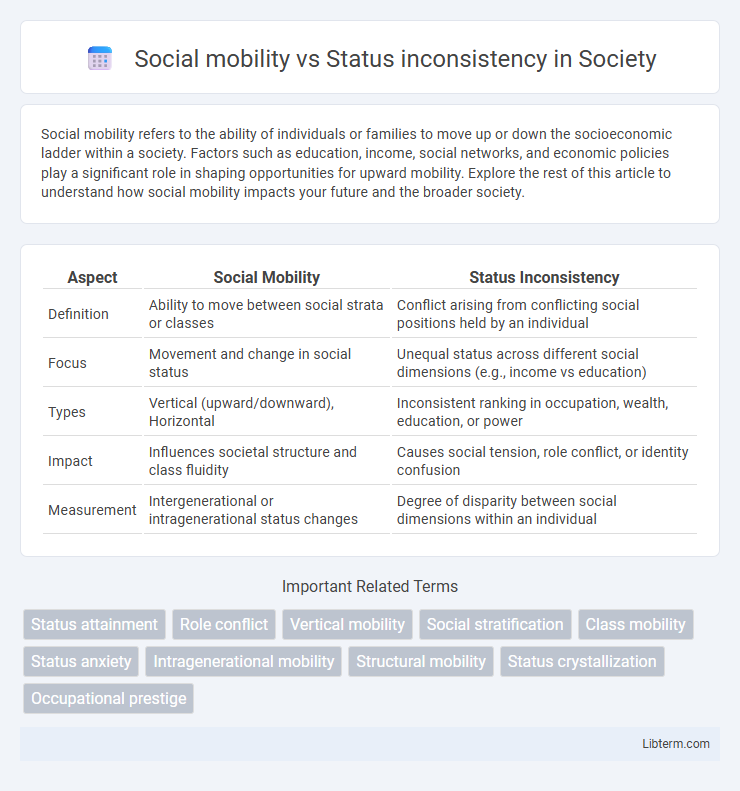Social mobility refers to the ability of individuals or families to move up or down the socioeconomic ladder within a society. Factors such as education, income, social networks, and economic policies play a significant role in shaping opportunities for upward mobility. Explore the rest of this article to understand how social mobility impacts your future and the broader society.
Table of Comparison
| Aspect | Social Mobility | Status Inconsistency |
|---|---|---|
| Definition | Ability to move between social strata or classes | Conflict arising from conflicting social positions held by an individual |
| Focus | Movement and change in social status | Unequal status across different social dimensions (e.g., income vs education) |
| Types | Vertical (upward/downward), Horizontal | Inconsistent ranking in occupation, wealth, education, or power |
| Impact | Influences societal structure and class fluidity | Causes social tension, role conflict, or identity confusion |
| Measurement | Intergenerational or intragenerational status changes | Degree of disparity between social dimensions within an individual |
Defining Social Mobility: Concepts and Types
Social mobility refers to the movement of individuals or groups within a social hierarchy, encompassing intergenerational and intragenerational shifts in socioeconomic status. It includes various types such as vertical mobility, which involves upward or downward movement in social rank, and horizontal mobility, where changes occur in occupation or location without affecting social status. Understanding these concepts is crucial for analyzing patterns of inequality and social stratification.
Understanding Status Inconsistency: A Sociological Perspective
Status inconsistency occurs when an individual's social positions have both high and low rankings across different dimensions such as occupation, education, and income, creating conflicting social expectations. Sociological research reveals that this mismatch often leads to stress, identity conflicts, and challenges in social interactions due to inconsistent social esteem. Understanding status inconsistency provides insight into how individuals navigate complex social hierarchies and the impact on social mobility patterns.
Historical Context: Evolution of Social Mobility and Status Inconsistency
Historical analysis reveals that social mobility evolved significantly during the Industrial Revolution as expanding economies and educational opportunities expanded upward movement across class structures. Status inconsistency emerged more prominently in modern societies with complex occupational hierarchies, where individuals hold divergent social ranks in income, education, and prestige, challenging traditional class stability. Understanding the interplay between increasing social mobility and persistent status inconsistency is crucial for analyzing shifts in social stratification from feudal to contemporary capitalist systems.
Key Factors Influencing Social Mobility
Economic resources, educational attainment, and occupational opportunities are key factors influencing social mobility, determining an individual's ability to move within social hierarchies. Status inconsistency occurs when a person's social positions have both high and low rankings across different dimensions such as income, education, or prestige. Understanding the disparities in wealth, access to quality education, and discrimination reveals how these factors contribute to both social mobility and status inconsistency.
Causes and Manifestations of Status Inconsistency
Status inconsistency arises when an individual's social positions across different dimensions, such as education, income, and occupation, do not align, causing conflicting social status. Causes include rapid economic changes, occupational shifts, and educational achievements that outpace income or prestige, leading to mismatched social rankings. Manifestations of status inconsistency involve social tension, identity confusion, and challenges in gaining respect or influence within peer groups or communities.
Societal Implications: Comparing Outcomes of Mobility and Inconsistency
Social mobility often leads to increased economic opportunities and social integration, promoting societal cohesion and reducing inequalities. Status inconsistency, where individuals experience conflicting social rankings across dimensions like income, education, or occupation, can create tension and social strain, potentially undermining social trust. These contrasting outcomes highlight the importance of promoting mobility to foster equality, while addressing the challenges posed by status inconsistency to maintain social stability.
Social Mobility and Status Inconsistency in Different Cultures
Social mobility varies significantly across cultures, influenced by factors such as education systems, economic opportunities, and social norms, which can either facilitate or hinder individuals' movement within the social hierarchy. Status inconsistency occurs when an individual's social positions across different dimensions--such as occupation, education, and income--do not align, creating conflicting social expectations and experiences. Different cultures perceive and manage status inconsistency differently; for example, Western societies may emphasize occupational prestige, while Eastern cultures might prioritize family lineage and community standing, impacting the social mobility trajectories within these societies.
Policy Approaches: Enhancing Mobility and Addressing Inconsistency
Policy approaches enhancing social mobility prioritize equitable access to education, job training, and affordable housing, promoting upward economic movement across generations. Addressing status inconsistency involves targeted interventions to reconcile disparities between occupational prestige, income, and education, such as credential recognition programs and inclusive labor market policies. Effective strategies combine social welfare investments with anti-discrimination laws to create cohesive frameworks reducing inequality and enabling stable social positioning.
Real-Life Examples: Case Studies of Social Mobility and Status Inconsistency
Real-life examples illustrate social mobility through the story of Oprah Winfrey, who rose from poverty to become a media billionaire, showcasing upward mobility across economic and social status. In contrast, status inconsistency is evident in doctors who experience high occupational prestige but lower income compared to corporate executives, revealing conflicting social rankings. Case studies of immigrants often highlight these dynamics, where individuals achieve upward mobility despite encountering social status inconsistencies tied to cultural or educational credentials.
Future Trends: Navigating Social Mobility and Status Inconsistency in Modern Societies
Future trends in social mobility highlight increasing opportunities for individuals to move across economic and social classes through education, technology, and globalization. However, status inconsistency remains a challenge as people may experience conflicting levels of prestige, income, and power within emerging hybrid occupational roles. Understanding and navigating these dynamics requires adaptive social policies and innovative frameworks that address disparities in access and recognition.
Social mobility Infographic

 libterm.com
libterm.com